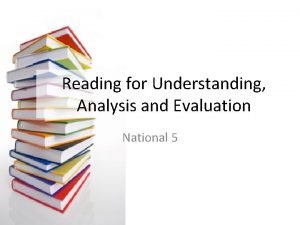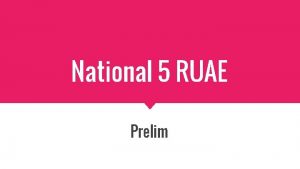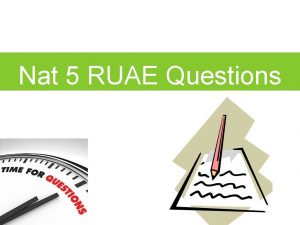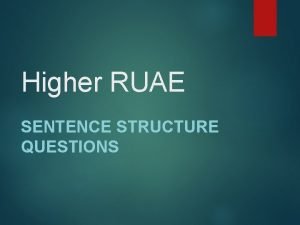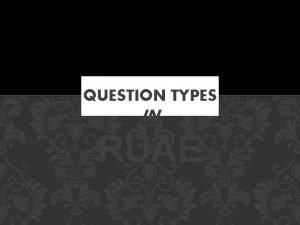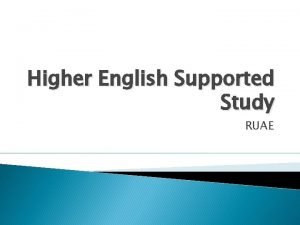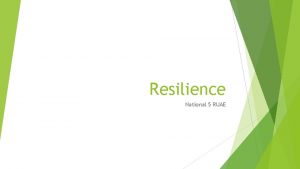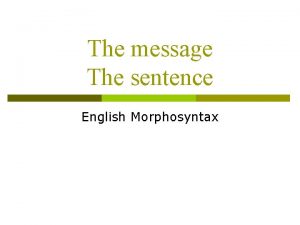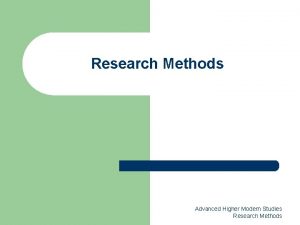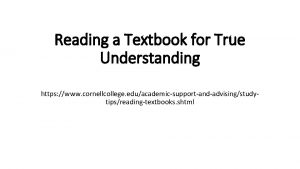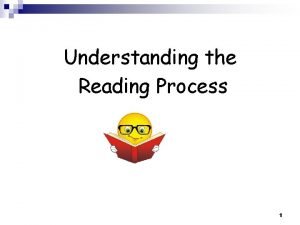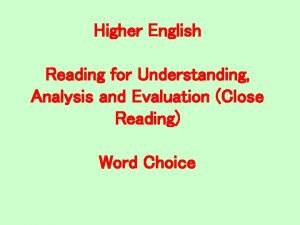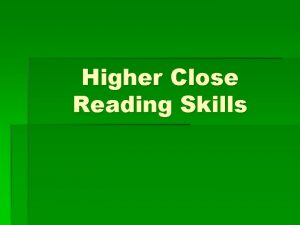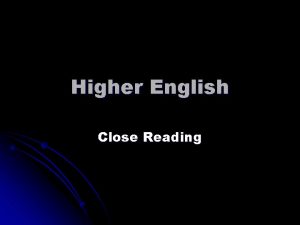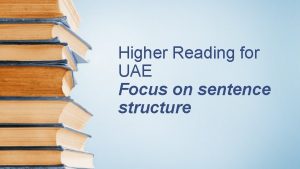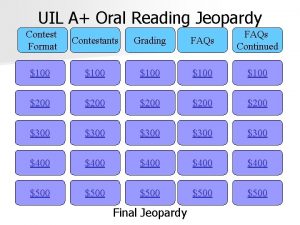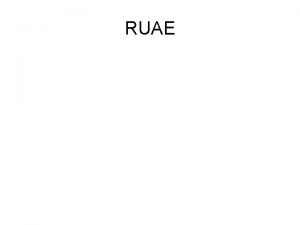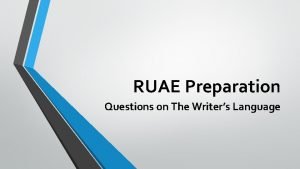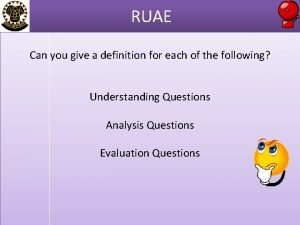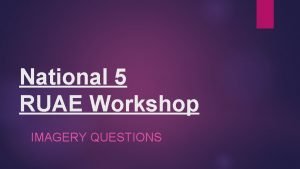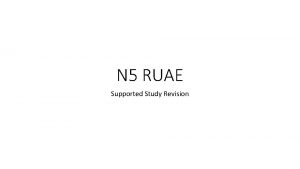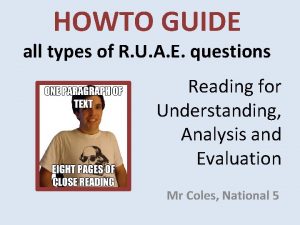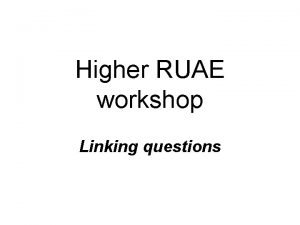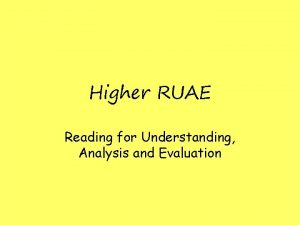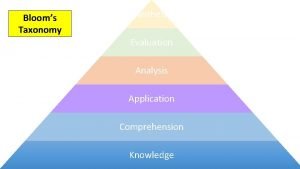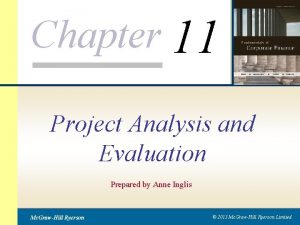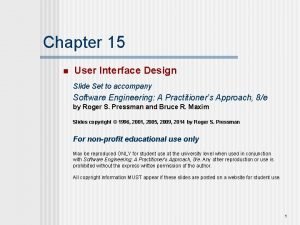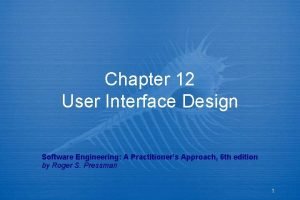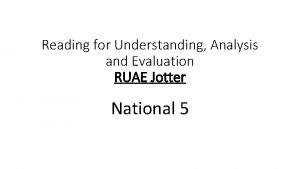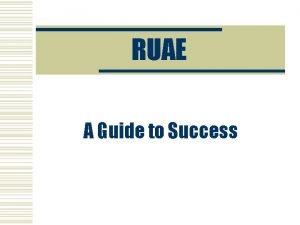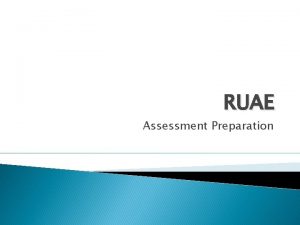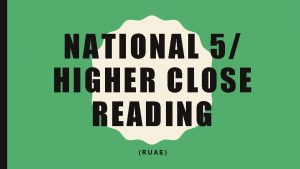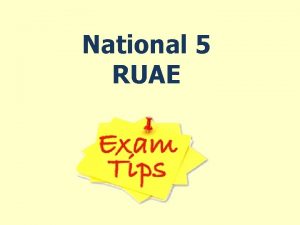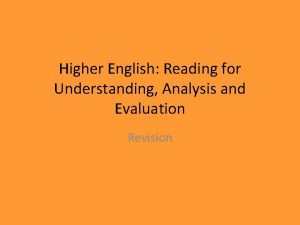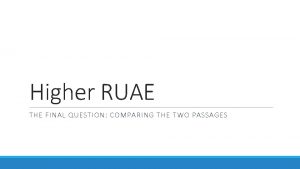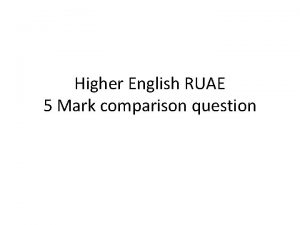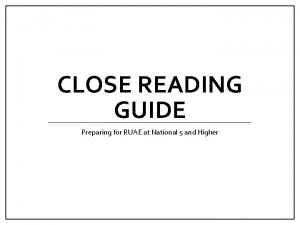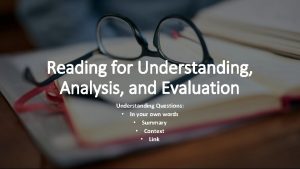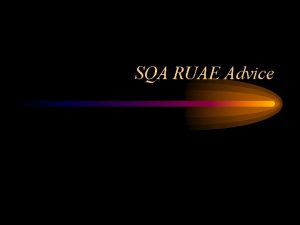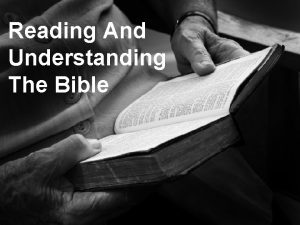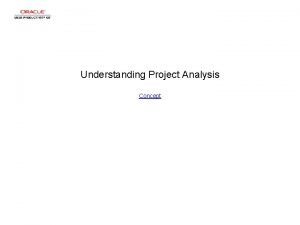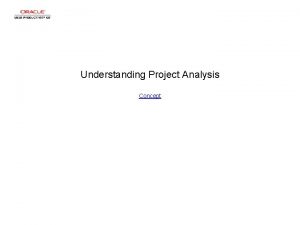Higher RUAE Reading for Understanding Analysis and Evaluation





























































































































- Slides: 125

Higher RUAE Reading for Understanding, Analysis and Evaluation

The Exam • Duration: 1 hour, 30 minutes • Total marks: 30 • 2 passages – 1 st passage + analysis questions = 25 marks – Compare 1 st and 2 nd passage (areas of agreements and/or disagreements) = 5 marks • Use your checklist!

Revision Techniques • Put every term and definition onto a flashcard AS YOU GO • Read broadsheet newspaper articles and annotate them • Use old past papers wisely • Speak to me if you are unsure about any technique • Watch/listen to satirical comedy • Use your checklist to reflect on progress

Show Understanding • • Own words Bullet points One point per mark Includes: – Summarise points made – Show understanding of word from context – Show sentence performs linking function

Example: Thinking of Grandpa now, I recall the clouds of pungent smoke that he puffed from his favourite briar, his small shrewd eyes, still very blue, and the gleaming dome rising from fleecy tufts of white hair • Question – What three characteristics of Grandpa does the author remember? 3 marks

Answer and Explanation • She remembers her grandfather smoked a strongsmelling pipe. He also had intelligent blue eyes and a bald head with a little fluffy white hair. • Explanation / Method • Understanding of ‘briar’ – shown by using the word ‘pipe’ • Metaphor ‘gleaming dome’ – simplified to bald head • Understanding of ‘shrewd’ – shown by using the word ‘intelligent’ • ‘Grandpa’ is colloquial – more formal term ‘Grandfather’ is used • ‘Eyes’ is a common word, no obvious alternatives

Understanding Question Read lines 1 – 7 Explain in your own words why the writer seems surprised that there is so much coverage of the “countryside debate”. 2 marks Rural Mania The “countryside debate” has rarely been out of the news in Britain in recent years. Reading the newspapers, watching television, listening to the radio, entering a bookshop, one could be forgiven for thinking that we still live in small peasant communities dependent upon the minutest shift in agricultural policy. Sometimes it has seemed almost as if we were still in the early nineteenth century when we relied on the countryside to survive, so extensive have been the debates, so fierce the passions aroused.

Answer “one could be forgiven for thinking that we still live in small peasant communities dependent upon the minutest shift in agricultural policy. ” ⦿Idea that we are still a rural society (1) affected by farming laws (1) “it has seemed almost as if we were still in the early nineteenth century when we relied on the countryside to survive” ⦿Idea that we are still living in the past (1) when we were more rurally dependent (1)

Read lines 21 – 29 Referring to lines 25 – 29, explain in your own words what the writer believes to be a ‘particularly worrying aspect of the new rural mania’ (line 23). 2 marks It might be thought—indeed, it is widely assumed—that it must be good for the countryside to be returned to the central position it enjoyed in British life long ago. Yet there is a particularly worrying aspect of the new rural mania that suggests it might finally do the countryside more harm than good. This is the identification, in the current clamour, of the countryside in general and the landscape in particular with the past—the insistence on the part of those who claim to have the best intentions of ruralism at heart that their aim is to protect what they glibly refer to as “our heritage”. This wildly overused term is seriously misleading, not least because nobody appears ever to have asked what it means.

Answer ⦿Any of the following ideas: ⦿That rural features are the only way of understanding our history ⦿Desire to preserve what is perceived as “our heritage” ⦿Difficulty heritage” in defining what is meant by the term “our Now complete practice questions in Higher English Language Skills

Remember… • You don’t have to translate the text – if words are already very simple you shouldn’t have to change them. • Read the passage as a whole – what is it about? Do you get the gist? • How many marks is this question worth? This should give you a clue as to how much information is necessary. • Finally, never repeat phrases or complicated words – these are the aspects of the passage you are being tested on!

Understanding – context questions • In “Context” questions, you will be asked to • explain the meaning of a word or phrase, • show you deduced the meaning from its position in the text by quoting clues in the sentences surrounding the word. You must explain how they help to confirm the meaning. • It is usually possible and advisable to quote two pieces of evidence.

Example • The rumour that Douglas was a prisoner was still unsubstantiated. There had been no witnesses to his bailing out of the plane, and no solid information could be expected from beyond enemy lines for weeks, perhaps even months. • Show the context helped you arrive at the meaning of the word unsubstantiated.

Answer • The word “unsubstantiated” means unconfirmed. The context conveys this: “no witnesses” who could say for sure the news was true, and the phrase “no solid information” also repeats the idea of there being no firm proof.

Example • Glasgow’s constant proclamation of its present success story is justified on the basis that it benefits the city: confidence will breed confidence, tourists will visit, businesses will relocate and students will enrol. But, despite the gains this approach has brought for Glasgow and cities like it, there are signs that the wind is starting to come out of the sails. What felt radical when Dublin, Barcelona and Glasgow embarked on the city makeover path in the late 1980 s and early 1990 s, now feels derivative and is delivering diminishing returns. When every city has commissioned a celebrity architect and pedestrianised a cultural quarter, distinctiveness is reduced to a formula. • What does the writer mean by the words “radical” (line 13) and “derivative” (line 14) in his discussion of city development?

Answer • Radical – this means original, drastic, different. • This is clear because the writer mentions cities employing popular architects “celebrity architects” and referring to the idea of the entire city being made different “City makeover”. • Derivative – unoriginal, imitative, copied. • This is clear as the writer uses a list of other cities who have used a similar approach to highlight the extent that this has been done before. Now complete the examples in the language skills textbook.

Linking Sentence • Show once sentence provides a ‘link’ in the argument. • Quote the part of the sentence which refers back to the earlier topic • Explain what this topic is • Quote the part of the sentence which looks forward to the next topic • Explain what this topic is This formula will NEVER change!!!

And when I hear politicians—most of them comfortably off—trying to deny enlightenment and pleasure to “working class” people, I reach for my megaphone. Maybe Tommy Tattoo and his mates do use cheap flights to the sunshine as an extension of their binge-drinking opportunities, but for thousands of people whose parents would never have ventured beyond Blackpool or Rothesay, air travel has been a social revelation. So, before we all give the eco-lobby’s anti-flying agenda the unconditional benefit of the doubt, can we just review their strategy as a whole? Remember, it is not just air travel that the green tax lobby is trying to control: it is a restriction on any mobility. Clamping down on one form of movement, as the glib reformers have discovered, simply creates intolerable pressure on the others. Londoners, for example, had just become accustomed to the idea that they would have to pay an £ 8 congestion charge to drive into their own city when they discovered that the fares on commuter rail and underground services had been hiked up with the intention of driving away customers from the public transport system—now grossly overcrowded as a result of people having been forced off the roads by the congestion charge.

Question Referring to specific words and/or phrases, show the sentence “So, before … as a whole? ” (lines 13 -14) performs a linking function in the writer’s argument.

Example • William Shakespeare is easily the best-known of our English writers. Virtually every man in the street can name some of his plays and his characters, and many people can also recite lines of his poetry by heart. However, despite our familiarity with his work, we know relatively little of the man himself. We do not know when or why he became an actor, we know nothing of his life in London, and almost nothing of his personal concerns. • Question • Show the third sentence acts as a link in the argument.

Revision • Read the comments/opinion sections of broadsheet newspapers • Pick out two linked paragraphs from one of these and summarise the main points made by the writer • Highlight a linking sentence and explain how it performs a linking function • Find a word you don’t understand attempt to figure it out from the context – then look it up to check that you were right.

• • • • Figures of Speech Imagery (simile, metaphor, personification) sight Alliteration Onomatopoeia sound Pun Hyperbole Overstating Litotes (understatement) Circumlocution understating Euphemism talking in circles Paradox Oxymoron Juxtaposition Contrasts, opposites, contradictions Neologism Archaism Cliché New, old and overused

Imagery • An imagery questions will require you to focus on analysing metaphor, simile or personification. • There are different styles of answering this question, however we will focus on using the ‘just as, so it is, this is effective because’ method.

When I was 18 I travelled to Indonesia. When I returned home I held the inevitable slideshow for long-suffering friends. There was a shot of an old farmer. He was as sinewy as a Balinese carving. He stands, unsmiling, holding onto some willowy branches, as if he has indeed been hewn from the tree. “Don’t you mind taking pictures of people? ” asked a friend. I thought it a strange question. There was a perfect picture opportunity and I made the most of it.

Just as a “Balinese carving” features lots of thin intricate lines, so it is in the passage that the farmer is slim with sinews in his body that form lots of intricate and patterned lines. This is effective because it highlights what an attractive subject the farmer is for a photograph as he looks like a work of art. Given that writer is questioned about why he takes such photographs, it strengthens his argument that it was indeed a “perfect picture opportunity”.

Near Bombay there are historic caves which are a popular day-trip destination. Climbing several hundred steps, you are assaulted by trinket-sellers, café owners, monkeys and, most bizarre of all, village women with empty water-pots on their heads. They run ahead of you to pose stiffly and insist that you take a picture. Then they ask for money. These women know what tourists want: an “authentic” look. No plastic water containers, please.

Just as an “assault” involves attacking someone forcefully and perhaps unexpectedly, so it is in the passage that the various village people unexpectedly surround the writer, almost attacking him as they approach and offer themselves as possible subjects for a photograph. This is effective because it highlights how keen these people are to have their photograph taken and also gives a sense of how many there are. The negative connotations of “assault” underline the writer’s point that this is not an altogether pleasant experience.

I am inclined to see the shape of British postwar history as having been not unlike that of a gigantic wave. It was a wave which began to gather in the mid-Fifties, as the world finally began to emerge from the shadows cast by the Second World War – a wave of expectation, of nervous excitement, born of the growing sense that somehow Britain, the West and mankind were moving forward into a new era, of a kind never known before.

• Just as a ‘gigantic wave’ is a large, fast, overpowering and frightening force that can destroy everything in its path and change the landscape forever; so it is in the passage that British post-war history is a period of time when a lot of things changed forever, at a frightening speed and with a powerful force that moved into the next century. This is effective because the comparison allows us to look back over history and appreciate the sheer scale and speed in which everything changed.

Above all in the late Sixties there were the first signs of a growing weariness with the relentless battering of change. Around 1967, we suddenly began to hear a new set of words – “conservation”, “the environment”, “pollution”, “ecology” – expressing a growing sense of horror at what our wonderful, runaway technology was doing to our cities, to our countryside and rivers and seas, to other species, to the whole balance of nature on the planet. Somehow, the feeling ran, things seemed to have got out of hand.

Having invented the modern city, 19 th century Britain promptly reeled back in horror at what it had done. To the Victorians exploring the cholera-ridden back alleys of London’s East End, the city was a hideous tumour sucking the life out of the countryside and creating in its place a vast polluted landscape of squalor, disease and crime. In their eyes, the city was a place to be feared, controlled and, if possible, eliminated.


Figures of Speech - Sound • Alliteration: A series of words in which the same letter is repeated, usually at the beginning of two or more words in order to create a particular effect. • He carried a box of books up to the storeroom on the top floor of the building. • There are three words beginning with “b” here but all of them are simple nouns and there does not appear to be any particular literary effect intended. However, when the travel writer Patrick Leigh. Fermor, describing a town in Holland, talks about the • clip-clop of clogs on the cobblestones • the alliteration is clearly deliberate: you can almost hear the rhythmical sound of the wooden shoes on the street.

Figures of Speech - Sound • Onomatopoeia is a name given to words which imitate the sound they are describing. Often used in conjunction with alliteration. As in the above quotation, alliteration helps to create an onomatopoeic effect. This is how D. H. Lawrence describes a snake drinking from a water trough in his poem Snake: He sipped with his straight mouth, Softly drank through his straight gums, into his slack long body, Silently. • The alliteration of the letter “s” (also known as sibilance) creates a “hissing” effect appropriate to a description of a snake.

Figures of Speech - Sound • Pun: a play on words involving words which sound similar but have different meanings. Usually the intended effect is humour “Waiter!” “Yes sir? ” “What’s this supposed to be? ” “It’s bean soup, sir. ” “I don’t care what it’s been. What is it now? ”

Figures of Speech overstating, understating, talking in circles • Hyperbole is a deliberate exaggeration in order to emphasise the point being made – often for a humorous effect. The television presenter Clive James often uses this technique with great skill. He describes Marlon Brando as “Hollywood’s number one broody outcast” and says that: • He could order a cheeseburger with fries and make it sound like a challenge to the Establishment. • Extract from Fame in the Twentieth Century by Clive James

Figures of Speech overstating, understating, talking in circles • Litotes is the opposite of hyperbole: deliberate understatement. In My Family and Other Animals, Gerald Durrell writes of his mother: On Monday morning I found her in the garage being pursued round and round by an irate pelican which she was trying to feed with sardines from a tin. “I’m glad you’ve come dear, ” she panted, “this pelican is a little difficult to handle. ” • As with so many other figures of speech, hyperbole and litotes are not confined to writing but are often used in everyday conversation: Isn’t there anything to drink? I’m dying of thirst! (Hyperbole) The teacher wasn’t exactly overjoyed when I told her that I’d left my work at home. (Litotes)

Figures of Speech overstating, understating, talking in circles • Euphemism: a way of making an unwelcome truth seem less harsh or unpleasant by dressing it up in inoffensive language. Many euphemisms are connected with the subject of death, e. g. saying “passed away” rather than “died”. • Euphemisms are equally plentiful in the world of politics. One of the most famous examples came from the 1950 s Prime Minister, Sir Anthony Eden, who once said “We are not at war with Egypt. We are in a state of armed conflict. ”

Figures of Speech contrasts, opposites and contradictions • Paradox: a statement which appears to be a contradiction but which, on closer examination, does contain a truth. For example, to preserve the peace, prepare for war • This seems to be a contradiction, but it is based on the “deterrent” idea that if one side builds up its military strength then the enemy will not dare to attack, and thus peace will be maintained. • The oft-quoted comment by Oscar Wilde is an example of paradox: “Nowadays people know the price of everything, and the value of nothing. ”

Figures of Speech contrasts, opposites and contradictions • Oxymoron: a condensed form of paradox, in which two opposites are place side by side to heighten the effect of contrast. • Edwin Muir’s poem The Horses ends with horses coming to a group of human survivors of a nuclear war and voluntarily allowing themselves to be used to plough the land: the poet describes their action as: • “free servitude”.

Figures of Speech contrasts, opposites and contradictions • Juxtaposition simply means placing side by side. In the example of oxymoron, it could be said that the two opposites are placed in juxtaposition. A writer might deliberately place two sentences beside each other to highlight the contrast between them. Dustin Hoffman became famous in the sixties in The Graduate playing a nervous young man who suspected that life in America was stacked against him. In the seventies he became more famous still as an even more nervous, slightly less young man, who knew that life in America was stacked against him.

Figures of Speech new, old and overused • Neologism: coining of a new word, usually to describe a recent development or invention for which an appropriate term does not exist. microwave oven, filofax, sky plus, video-conferencing • Archaism: denotes a word from the past which is no longer in current use, the opposite of neologism. Arm thyself lightly, mount to horse, keep thy land, aid thy men, hurtle into the press. Thou needest not to strike another, neither to be smitten down. • A writer may deliberately try to write in an archaic style in an attempt to recapture the feel of a historical period. • Cliché: an expression which at one time might have been original but has now become overused, • “in this day and age” or “as white as snow” are clichés and should be “avoided like the plague”

A wee test • Next week there will be a wee class quiz to test your knowledge of all the language techniques you have learned so far • If you do not know any, you will be required to write out their definitions five times each.

The wee test • Explain the steps for answering a context question • Explain the steps for answering a linking sentence question • Write down definitions for the following: – – Juxtaposition Oxymoron Archaism Cliché • Identify the technique: – “I can resist anything except temptation”

Word Choice • Once you feel confident in answering questions relating to word choice, you may find that this is one of the easiest ways to pick up marks. • Main thing to always focus on – CONNOTATIONS AND EFFECTS

Look out for… • Verbs • Adverbs • Adjectives • “Stress” words – will, should, have to, might, can’t, won’t – never, always, often, sometimes, maybe

Layout of answer • “Quotation of word” • Connotations • How it (does what the question asks) or The word “_____” has connotations of… This (use the words from the question) by suggesting…

How does it make clear the change in attitude to “living together outside marriage”? In the past, living together outside marriage was seen by liberals as a definite choice, as a rebellious stance, whereas now it is usually seen as mere laziness, as a pale imitation of the real thing.

• “rebellious” • Connotations: rule breaking, going against authority • Makes clear the change in attitude by suggesting that then people who didn’t get married were breaking society’s rules of what a couple should do. The word “imitations” has connotations of something being fake and not as good as the real thing. This makes clear the change in attitude by suggesting that people who don’t get married now are seen as merely engaging in a poor copy of marriage that is not as good as the real thing.

How does it convey his strength of feelings about what he had done? When I think about it now, I cringe. How could I feel I had the right to control someone, just to get a photo? But it’s something you see everywhere: the abuse of the power of the camera.

• “Quotation of word” • Connotations • How it conveys the strength of feelings about what he had done or The word “_____” has connotations of… This conveys the strength of feelings about what he had done by suggesting…

How does it convey his attitude to photographers? For photographers, the story of the interaction with their subjects has a different ending, and they scuttle away clutching little plastic containers from which to recreate a few frozen moments in the easy comfort of First World sitting rooms. After the rounds of polite congratulation, the bundle of memories is then stuffed into a drawer often never to be looked at again.

• “Scuttle” • Has connotations of an unpleasant creature running away quickly in a sneaky, skitterish manner • Coveys attitude to photographers by suggesting that what they do is disgusting, unpleasant, sneaky and cowardly.

How is it used effectively to emphasise her point of view that speaking “properly” should be encouraged? Good speaking is a powerful force for social mobility. Children from articulate families who talk together over meals have a huge advantage from the start; the others, who rarely converse with adults and are bored by school, either communicate in grunts or adopt the comparative richness of street slang, rap and patois. You may be communicating beautifully with your friends, but you are excluded from all the best chances if you can’t command your own language to serve you properly. And even if you do haul yourself into a decent job you will never be confident, never joyfully articulate. Owning a fine language should be a source of pride, not shame.

Using the word choice sheet • You will be given a sheet with some word choice examples • Complete this on your own and then swap with a partner. • Discuss your answers, change if necessary and then hand in.

Revision • Read a passage from either a past paper or a newspaper. • Find analyse both imagery and word choice.

Sentence Structure

Commenting on sentence structure • A very broad area of RUAE • You need to learn all sentence structure techniques – no getting around them! • You need to be able to explain what effect is created by these techniques

Answering a sentence structure question • Sentence structure refers to how a sentence is put together. This is often one of the most difficult questions as there are so many options. • Identify a feature of sentence structure • Quote the example • Comment on the effect. – Remember that the effect will depend on the context of the passage!

What not to do • Don’t just identify a technique such as parenthesis. • Explain what information is in the parenthesis • Explain the effect putting this information into parenthesis has

Sentence Structure Sentence Punctuatio Sentence Types n lengths patterns

Sentence Types • Command • Question (and rhetorical questions – persuasion) • Exclamation • Statement • minor sentence (no verb: creates impact and informality)

Paragraphing • When a writer wishes his writing to have instant impact, or to be particularly easy to understand, he uses very short paragraphs. • A single sentence paragraph may throw emphasis onto a statement or idea. It may be used to slow the action and create suspense.

revision • How do you answer a context question? • How do you answer a link question? • Can you remember the different types of sentences? • What significance does a one-sentence paragraph have?

Punctuation • Inverted commas – – – To indicate a title For spoken words For quotations To mark off a foreign word from a sentence To mark off a word or a phrase from a sentence to show that the writer is distancing himself from it • Colon – Introduces a quotation, a list, an explanation or an expansion of the previous statement

punctuation • Semi-colon – To separate clauses in a list – To balance two similar or opposing ideas in a sentence • Dash – To add on an extra piece of information – To add an after-thought – To indicate the breaking off in a sentence – A series of dashes could be used informally to convey an outpouring of ideas or emotions • Two dashes – Can mark off an extra, non-essential piece of information in the middle of a sentence – a technique known as parenthesis. This information can either be factual or the writer’s opinion.

Sentence patterns • • • List Inversion Repetition Climax Anti-climax Antithesis

Parenthesis and listing • Parenthesis has been used by the writer to include extra information/his opinion about… This makes the reader think of. . . • The writer has listed all the …. . To show that … This creates a …… (effect might be cumulative e. g. to show that there is more than what is there or to give the impression of an endless amount of blah)

inversion • The basic order for a sentence is subject verb object – I love English – I ate the cake • The subject will come first, followed by the words that tell us more about the subject (the predicate) – He climbed higher and higher • However, occasionally the predicate comes before the subject – Higher and higher he climbed • This technique, where the subject is delayed, is known as inversion and can be used to alter the emphasis in a sentence.

repetition • A writer may decide to repeat certain words in order to achieve a particular purpose. This purpose will depend on the context of the passage.

Climax and anti-climax • Climax refers to placing a number of items in ascending order, with the most important being kept to the last • Anti-climax refers to when the author builds up to something which does not in fact come.

antithesis • Another way of arranging ideas within a sentence is to balance opposites together to create a contrast – this is called antithesis. • E. g “My fellow Americans, ask not what your country can do for you; ask what you can do for your country. ” • Antithesis can be used to state a point in a memorable way; or it can be used to create a humorous effect.

Long and Short Sentences • Long sentences: often formal, can build tension or build up an argument • Short sentences: informal, used to create drama or impact

Revision Quiz • You will now be given a revision quiz that will test your knowledge of all sentence structure techniques – if you get any of these wrong you will have to write out their definitions five times.

A Wee Test • • 5 types of sentence Explain one function of a single sentence paragraph 3 uses of inverted commas 3 uses of a colon 2 uses of a semi-colon 3 uses of a dash (not parenthesis) Define: – Inversion – Anti-climax • Identify technique here: – “Failure to plan is a plan for failure”

Sentence Structure Steps • Step One: identify the aspect of sentence structure or punctuation • Step Two: explain why it has been used, linking this to the content of the passage • Step Three: relate back to the question

Where most critics allege a dumbing down, I see a progressive story: popular culture steadily, but almost imperceptibly, making our brains sharper as we soak in entertainment usually dismissed as so much lowbrow fluff. I hope to persuade you that increasingly the nonliterary popular culture is honing different mental skills that are just as important as the ones exercised by reading books.

Question: Show the writer’s use of language in lines 9 -14 (“Where … books. ”) emphasises the contrast between his positive view of “other forms of culture” and the negative view held by “most critics”. • The writer uses a colon in “I see a progressive story: ” • This is used to introduce a fuller development of his argument of the ‘progressive story’ • This emphasises his positive tone when writing about other forms of culture.

• The writer uses a balanced sentence structure of “Where most critics allege a dumbing down, I see a progressive story” • This contrast emphasises how positive he views the idea of ‘other forms of culture’ and how negative the critics view it. • This also makes the writer seem more sure of his idea, and the critics less certain – meaning that the reader will probably agree with the writer’s argument.

Example Questions Yet if you sweep away the apoplectic froth and the self-interested posturing and look at the reality, the “threat to the countryside” recedes dramatically. Yes, we do occupy a crowded little island. But what makes it seem crowded is that 98 per cent of us live on 7 per cent of the land. Britain is still overwhelmingly green. Just 11 per cent of our nation is classified as urban. Show the writer’s sentence structure emphasises his view that the threat to the countryside is much less serious than the English middle classes suggest.

Sentence Structure Question Identify an aspect of sentence structure and explain what the writer achieves by using it • Let every nation know, whether it wishes us well or ill, that we shall pay any price, bear any burden, meet any hardship, support any friend, oppose any foe to assure the survival and success of liberty.

Sentence Structure Question Identify an aspect of sentence structure and explain what the writer achieves by using it • The second and the third day passed, and still my tormentor came not. Once again I breathed as a free man. The monster, in terror, had fled the premises for ever! I should behold it no more! My happiness was supreme!

Varieties of language Formal language Informal language Usually written Usually spoken – or at least a written version of colloquial expressions No abbreviations Uses abbreviations Grammatically correct May use looser sentence structures Wider range of word choice, including complex or technical vocabulary More common, everyday words Impersonal tone Personal approach Tends to be factual May include feelings

Jargon • A type of formal language which includes technical terms relating to a particular subject or occupation.

Rhetorical language • Usually used to put across a particular stance as part of a dignified piece of writing • Often used in persuasive speeches • Makes use of the rhetorical question (ie the writer assumes you already agree with what they have to say)

Dialect and slang • Types of informal language • Dialect refers to language spoken in a particular area – E. g. Glaswegian, Galloway Irish, Caithness etc • Slang refers to non-standard English. E. g. words such as ‘innit’ • Now do the task on pages 33 - 35

Language • • Formal and informal language These techniques Jargon will help you identify tone – we will go over this Rhetorical language next week! Dialect and slang Literal and figurative language Figures of speech Contrasts, opposites and contradictions

Emotive language • Emotive language refers to particular words and phrases that are used to stir up the emotions of a reader. • 2 17 year old males stole a phone from a 50 year old woman • 2 thugs ruthlessly mugged a grandmother • The writer might also use hyperbole, repetition, exclamations and rhetorical questions to make his language emotive.

Revision • Revise all types of language for another wee quiz – remember if you get any answers wrong you will be required to write the correct answer out five times!

A Wee Test • Write down three key features of formal language • Define rhetorical language • What is the different between dialect and slang?

Tone • Tone does not relate directly to meaning but rather to the way in which something is said. It refers to a particular attitude or feeling conveyed by the writer. • In speech, the tone of voice used would make the speaker’s feelings clear. In writing, however, you must look at the word choice to find clues to the feeling or attitudes of the author.

• • • humorous flippant informal and conversational friendly effusive Irony tongue-in-cheek satirical serious formal, Ponderous Emotive Tone Varieties

Humorous Tone • If the writer is being light-hearted, or humorous in a straightforward way, shows the author finds his subject amusing and he hopes his reader will too. • A light-hearted tone will often include informal and conversational language, (colloquialisms)

Flippant Tone (linked to humour) • A flippant tone is where the author is showing an irreverent attitude to something normally taken seriously. • An example is to be found in Philip Larkin’s poem Church Going, where the poet enters a church and describes the altar thus: “some brass and stuff, up at the holy end. ” • Here the use of colloquial and informal expressions conveys his lack of respect.

Conversational Tone • A conversational tone describes a particularly chatty, friendly tone, as if the writer is confiding in a friend. • An example is the narrative tone in the opening chapter of Sunset Song by Lewis Grassic Gibbon, where the writer is gossiping to his readers about his characters: • “Chae…wasn’t the quarrelsome kind except when roused, so he was well-liked, though folk laughed at him. But God knows, who is it they don’t laugh at? ”

Effusive or Persuasive • Effusive tones are often filled with enthusiasm and are frequently used in advertising. • A list of gushing superlatives would be an example of this. – Excessive or exaggerated praise

Ironic Tone • Irony is the name given to the figure of speech where an author says the opposite of what he really means. • This could be purely for humorous effect, but there is often a serious purpose behind irony. An author’s feelings can be expressed more forcefully for being inverted in this way.

Tongue-in-Cheek Tone • A tongue-in-cheek tone is a form of irony: the writer will sound serious, but there will be a sense of ridicule behind this. • Euphemism is a common feature of this tone. An example might be the expression “tired and emotional” to mean “drunk” which the satirical magazine Private Eye uses to avoid lawsuits from the prominent people whom it exposes.

Satirical Tone • A satirical tone is an extreme form of irony, involving a writer being funny in a savage way: he holds a subject up to ridicule in order to attack it. • This is the tone adopted by George Orwell in Animal Farm, for example, where he satirised Russian Communists by comparing them to pigs. The satirist’s purpose is deeply serious although on the surface he may appear light-hearted.

Irony, Sarcasm and Satire • Irony – Verbal Irony • When someone says the opposite of what they mean, usually to convey their attitude towards the subject that they are speaking of. – Satire • The use of irony for critical purposes – Sarcasm • Irony used to mock, criticise harshly, or ridicule someone

Irony – Identify the ironic phrases below • The Circumlocution Office was (as everybody knows without being told) the most important Department under Government. No public business of any kind could possibly be done at any time, without the acquiescence of the Circumlocution Office. If another Gunpowder Plot had been discovered half an hour before the lighting of the match, nobody would have been justified in saving the parliament until there had been half a score of boards, half a bushel of minutes, several sacks of official memoranda, and a family-vault full of ungrammatical correspondence, on the part of the Circumlocution Office. • This glorious establishment had been early in the field, when the one sublime principle involving the difficult art of governing a country, was first distinctly revealed to statesmen. It had been foremost to study that bright revelation, and to carry its shining influence through the whole of the official proceedings. Whatever was required to be done, the Circumlocution Office was beforehand with all the public departments in the art of perceiving – HOW NOT TO DO IT. • Through this delicate perception, through the tact with which it invariably seized it, and through the genius with which it always acted on it, the Circumlocution Office had risen to overtop all the public departments…

Serious Tones • A serious tone is obviously used for serious purposes, on solemn occasions: a funeral speech, for example. • Look out formal, or ponderous phrases

Emotive Tones • An emotive tone is used for serious purposes. It aims to stir up emotions in the reader, by shocking, angering or disturbing them by using words or expressions expressing extreme emotions. • Example: sports journalist criticising the tension at a Rangers/Celtic match: • Nowhere else on the planet do footballers perform in front of vast crowds so full of bile, hatred and bigotry. I have yet to find another place on the planet where a sporting occasion includes a ritual singing of some ditty celebrating a distant battle which took place 307 years ago. • Here the writes uses repetition, and hyperbole: “on the planet”; he uses words expressing extremes: “vast”, and strong emotions: “bile, hatred, bigotry”. He uses so called “loaded” words: for example, “some ditty” implies a sense of contempt.

Identify the ways the writer has used emotive language • Why Tonya the wicked witch is still running from her past • She answers the door of her rented house like a fugitive, her eyes nervously scanning the empty street. Tonya Harding cannot disguise the fact that she is a young woman on the run from a notorious past. • Her probation may have ended six months ago but she is discovering that, although she recently fled her old neighbourhood in Portland, Oregon, the scent of scandal clings to her like cheap perfume. • Almost four years ago, Harding became the most loathed and vilified sportswoman in the world when she was implicated in the violent plot to cripple Nancy Kerrigan, her American rival for Olympic figure skating glory. It was a crime motivated by monstrous greed an assault so cowardly that even now, with the next Winter Olympics fast approaching, Americans turn crimson with shame at the mention of her name.

Tone Question Steps • Identify the tone • Quote words or phrases and punctuation that helped you to identify the tone • Explain how these conveyed the tone used by the author by referring to the connotations of the words. • Comment on any figures of speech which reenforce the tone.

Tone Question 1: Identify the tone and explain how the writer achieves this. • Hulk goes into action against the heavies, flinging them about in slow motion. Like Bionic Woman, Six Million Dollar Man and Wonderwoman, Hulk does his action numbers at glacial speed. Emitting slow roars of rage, Hulk runs very slowly towards the enemy, who slowly attempt to make their escape. But no matter how slowly they run, Hulk runs more slowly. Slowly he picks them up, gradually bangs their heads together, and with a supreme burst of lethargy throws them through the side of a building. • Hardly have the bricks floated to the ground before Hulk is changing back into spindly David Banner, with a sad cello weeping on the soundtrack. One thinks of Frankenstein’s monster or the Hunchback of Notre Dame. One thinks of King Kong. One thinks one is being had. Why can’t the soft twit cut the soul-searching and just enjoy his ability to swell up and clobber the foe? But David is in quest of “a way to control the raging spirit that dwells within him. ” Since the series could hardly continue if he finds it, presumably he will be a long time on the trail.

Tone Answer 1 • Tone is humorous throughout by mocking the absurd techniques used in the TV show: slow motion to represent action. • ‘action numbers at glacial speed’, ‘supreme burst of lethargy’ – employs a list of oxymorons to emphasise the ridiculousness: • ‘heavies’, ‘sad cello weeping on the sound track’, mocking the clichés of the genre • ‘why can’t the soft twit…’ Uses colloquialisms to express his frustration at the silliness of the plot • Contrast of his down to earth language: ‘clobber the for’ with the pretentious programme language: ‘in quest of the way to control the raging spirit’ • ‘he will be a long time on trial’ - Ironic final statement

Tone Task • At your table get someone to read aloud the card • Discuss and agree as a group what the overriding tone is • Look at the card – pick out one language technique that helped you work this out • Write down the tone and analyse the technique on the sheet beside the card • Move on – decide whether you agree on the tone previously identified • Pick a different technique that supports this tone

Revision • Now revise all tones and their definitions, as well as how to answer the tone question. • You will be given a wee test – remember that any incorrect answers will have to be done again – 5 times!

A Wee Test • Write down the steps for answering a tone question • Write down definitions for the following tones: • Flippant • Effusive • Satirical • What is the difference between irony and sarcasm?

The effectiveness of the conclusion to the passage as a whole • Explain how effective it is • Look at the number of marks • If the number is three – find three quotations from the conclusion that help summarise or link back to ideas in the passage. • Quote the expression, explain the link and mention the idea from the whole passage

The Final Question on two passages - what will this question look like? • Consider the attitude displayed by each writer. Identify key areas of agreement and disagreement in their points of view. – You should support your answer by referring to important ideas in the passages. – You may present your answer to this question in continuous prose or in a series of developed bullet points. • Or key areas of agreement • Or key areas of disagreement

Read the question properly • • Agreement? Disagreement? Agreement and disagreement? Agreement or disagreement? • 5 marks

How many areas? • Between 4 and 5 • You will get marks for correctly identifying the key areas, and marks for supporting your answers by referring to the passage • Bullet point the key areas

• 5 marks How to get 5 marks – identification of essential areas (4 or 5), with an intelligent use of supporting evidence (quotations and explanations for each one) • 4 marks – identification of essential areas, with sound use of supporting evidence • 3 marks – identification of essential areas, with some supporting evidence • 2 marks – identification of only one essential area with reasonable supporting evidence • 1 mark – identification of only one essential area with minimal or no supporting evidence • 0 marks – failure to identify any essential area and/or complete misunderstanding of the task • Rule of thumb: one key area of agreement and one key area of disagreement (if the question asks you to look at both – otherwise two key areas of one or the other) + reference to the passages = 3 marks

Example bullet point • One key agreement is… For example, passage one stated that … “…” and passage two suggested that… “…” From these it is clear… • Another key agreement is… • However the writers disagree on … For the writer of passage one states that …. And this is clear when they say “…” yet the writer of passage two disagrees and suggests that … “…”

Look at your checklist • What are you confident with? • What are you not confident with?

Revision • Now you know all terms and definitions that will be assessed in RUAE • Read two articles on the same subject and FULLY annotate them (including effects created) • Write down the five main ideas for each writer • Explain where they agree/disagree

Give one, take one • Take two stickers – on one write down what you feel good at and on the other write down an area that you are unsure about • Go around the room, find someone who is good at the thing you are struggling with and get them to explain it to you • Similarly, look for someone who is struggling with what you are confident in and share your knowledge

RUAE Techniques • You will each write down one term and definition onto a flashcard (you will be told which one) • Go around the room and ask someone else to define that term/or steps for answering a particular question • You can give them a hint, but if they still don’t know then explain it to them • Once you have both shown you know what the two terms mean – swap your cards • Repeat process with everyone in the class

Terms and question types • • • • Context question Linking question Sentence structure question Imagery question Tone question Word choice question Final question Effective conclusion question Colon Semi-colon Dash Inverted commas Parenthesis Inversion • • • • Sentence types Flippant tone Irony Satirical tone Effusive tone Jargon Antithesis Climax Litotes Pun Minor sentence Neologism Oxymoron Paradox

Class Revision notes • Working in pairs: – you will be given an area of RUAE and 1 -2 A 4 sheets of blank paper – Write down all your helpful hints and tips – including an example from a past paper and possibly acronyms or mind maps or anything else you can think of – Be as neat as possible – Don’t write anything too near the margin • I will then take all of these pages and turn them into a revision book for the class to use before the exam.

Team Games tournament • You will need: – Groups of four – A RUAE question paper – A blown up version of the passages – everyone must read this before we begin – A score sheet – Scissors (to cut out your score strip at the end)

Close Reading Team Games Tournament • Start in a team of 4 (where possible) and give yourself a name – this is your home team. • Then move into new groups of four – there should be no member of the same home team in a group • In your new groups, you will go round anti-clockwise, taking turns to ask each other questions from the paper given to you • Roles: – Reader – reads out a question – Recorder – writes down who is answering on the score sheet and whether they got the question right – Responder – answers the question – Rescuer - allowed to give one clue to the responder • Once one question has been answered, switch roles

At the end of the tournament • Cut the score sheet into strips and take back your strip to your home team • Count up how many questions were answered, how many points they were worth and how many points were won • Over 85% = chocolatey goodness for the whole team • Less than 85% = nothing – even if one member got every question right!
 Reading for understanding analysis and evaluation
Reading for understanding analysis and evaluation Higher english ruae sentence structure
Higher english ruae sentence structure Types of ruae questions
Types of ruae questions In your own words questions national 5
In your own words questions national 5 Question sentence structure
Question sentence structure Ruae question types
Ruae question types How to answer ruae questions higher english
How to answer ruae questions higher english National 5 ruae
National 5 ruae Ruae higher english
Ruae higher english Summarzer
Summarzer Pre reading while reading and post reading activities
Pre reading while reading and post reading activities Advanced higher pe understanding standards
Advanced higher pe understanding standards Advanced higher geography understanding standards
Advanced higher geography understanding standards Higher art understanding standards
Higher art understanding standards Advanced higher computing
Advanced higher computing Understanding standards advanced higher english
Understanding standards advanced higher english Advanced higher health and food technology
Advanced higher health and food technology Understanding standards advanced higher english
Understanding standards advanced higher english Advanced higher mathematics of mechanics
Advanced higher mathematics of mechanics Sqa understanding standards art and design
Sqa understanding standards art and design Advanced higher modern studies research methods
Advanced higher modern studies research methods Sqa higher psychology understanding standards
Sqa higher psychology understanding standards Higher photography project examples
Higher photography project examples Reading a textbook for true understanding
Reading a textbook for true understanding Understanding the reading process
Understanding the reading process How to answer word choice questions higher english
How to answer word choice questions higher english Higher close reading
Higher close reading Higher english close reading
Higher english close reading Higher reading for uae
Higher reading for uae Oral reading uil
Oral reading uil Aims of teaching reading
Aims of teaching reading Types of reading skills
Types of reading skills Real definition of extensive reading
Real definition of extensive reading For adult
For adult How to develop reading skills in students
How to develop reading skills in students Fspos vägledning för kontinuitetshantering
Fspos vägledning för kontinuitetshantering Typiska novell drag
Typiska novell drag Tack för att ni lyssnade bild
Tack för att ni lyssnade bild Vad står k.r.å.k.a.n för
Vad står k.r.å.k.a.n för Varför kallas perioden 1918-1939 för mellankrigstiden?
Varför kallas perioden 1918-1939 för mellankrigstiden? En lathund för arbete med kontinuitetshantering
En lathund för arbete med kontinuitetshantering Underlag för särskild löneskatt på pensionskostnader
Underlag för särskild löneskatt på pensionskostnader Personlig tidbok fylla i
Personlig tidbok fylla i Anatomi organ reproduksi
Anatomi organ reproduksi Vad är densitet
Vad är densitet Datorkunskap för nybörjare
Datorkunskap för nybörjare Stig kerman
Stig kerman Debatt artikel mall
Debatt artikel mall För och nackdelar med firo
För och nackdelar med firo Nyckelkompetenser för livslångt lärande
Nyckelkompetenser för livslångt lärande Påbyggnader för flakfordon
Påbyggnader för flakfordon Arkimedes princip formel
Arkimedes princip formel Publik sektor
Publik sektor Kyssande vind
Kyssande vind Presentera för publik crossboss
Presentera för publik crossboss Teckenspråk minoritetsspråk argument
Teckenspråk minoritetsspråk argument Plats för toran ark
Plats för toran ark Klassificeringsstruktur för kommunala verksamheter
Klassificeringsstruktur för kommunala verksamheter Epiteltyper
Epiteltyper Claes martinsson
Claes martinsson Centrum för kunskap och säkerhet
Centrum för kunskap och säkerhet Lågenergihus nyproduktion
Lågenergihus nyproduktion Mat för idrottare
Mat för idrottare Verktyg för automatisering av utbetalningar
Verktyg för automatisering av utbetalningar Rutin för avvikelsehantering
Rutin för avvikelsehantering Smärtskolan kunskap för livet
Smärtskolan kunskap för livet Ministerstyre för och nackdelar
Ministerstyre för och nackdelar Tack för att ni har lyssnat
Tack för att ni har lyssnat Mall för referat
Mall för referat Redogör för vad psykologi är
Redogör för vad psykologi är Matematisk modellering eksempel
Matematisk modellering eksempel Tack för att ni har lyssnat
Tack för att ni har lyssnat Borra hål för knoppar
Borra hål för knoppar Orubbliga rättigheter
Orubbliga rättigheter R formel
R formel Tack för att ni har lyssnat
Tack för att ni har lyssnat Rita perspektiv
Rita perspektiv Informationskartläggning
Informationskartläggning Tobinskatten för och nackdelar
Tobinskatten för och nackdelar Toppslätskivling dos
Toppslätskivling dos Mästare lärling modell
Mästare lärling modell Egg för emanuel
Egg för emanuel Elektronik för barn
Elektronik för barn Vad kallas den mantel som bars av kvinnor i antikens rom
Vad kallas den mantel som bars av kvinnor i antikens rom Strategi för svensk viltförvaltning
Strategi för svensk viltförvaltning Kung dog 1611
Kung dog 1611 Ellika andolf
Ellika andolf Sju för caesar
Sju för caesar Tack för att ni lyssnade
Tack för att ni lyssnade Avrunda decimaltal
Avrunda decimaltal Form dikt
Form dikt Inköpsprocessen steg för steg
Inköpsprocessen steg för steg Fuktmätningar i betong enlig rbk
Fuktmätningar i betong enlig rbk Ledarskapsteorier
Ledarskapsteorier Vad är hsil
Vad är hsil Myndigheten för delaktighet
Myndigheten för delaktighet Frgar
Frgar Sju principer för tillitsbaserad styrning
Sju principer för tillitsbaserad styrning Läkarutlåtande för livränta
Läkarutlåtande för livränta Kraftledning karttecken
Kraftledning karttecken Ramsa geometriska former
Ramsa geometriska former Shaktismen
Shaktismen Var finns arvsanlagen
Var finns arvsanlagen Bris för vuxna
Bris för vuxna Big brother rösta
Big brother rösta Ruae tips
Ruae tips Language questions ruae
Language questions ruae Ruae techniques
Ruae techniques Nat 5 ruae
Nat 5 ruae Ruae revision
Ruae revision Proviso in a sentence
Proviso in a sentence Ruae link questions
Ruae link questions Ruae techniques
Ruae techniques Linking question examples
Linking question examples Humorous tone
Humorous tone Addicted to shopping ruae
Addicted to shopping ruae Antithesis sentence structure
Antithesis sentence structure Ruae
Ruae Application synthesis evaluation
Application synthesis evaluation Project analysis and evaluation
Project analysis and evaluation Interface analysis means understanding
Interface analysis means understanding Interface analysis means understanding
Interface analysis means understanding St. louis
St. louis Edb net
Edb net Ordinary reading vs critical reading
Ordinary reading vs critical reading Pe cycle of analysis
Pe cycle of analysis
